The first review I saw for the Doms X1 pencil was on Leadfast after which, Michael was kind enough to send me one in a trade package. I’ve been hooked from the moment I saw the Leadfast review- royal blue and silver paint with slick silver foil imprint? Yes, please.
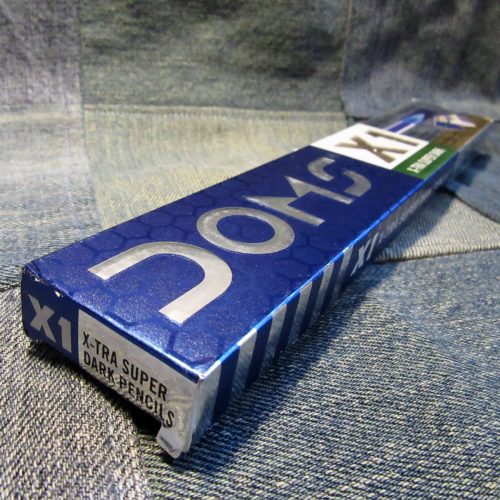 The X1 reminds me of a higher end Staedtler Rally- the paint is thick and glossy and on my package of 10, evenly applied. The blue is bright and on every other hex with silver paint between. The imprint is silver foil and white and applied on the blue sides. It’s clearly a pencil made for school kids as there is a spot to write your name. Fancy. The UPC is in the center but closer to the business end and printed in white.
The X1 reminds me of a higher end Staedtler Rally- the paint is thick and glossy and on my package of 10, evenly applied. The blue is bright and on every other hex with silver paint between. The imprint is silver foil and white and applied on the blue sides. It’s clearly a pencil made for school kids as there is a spot to write your name. Fancy. The UPC is in the center but closer to the business end and printed in white.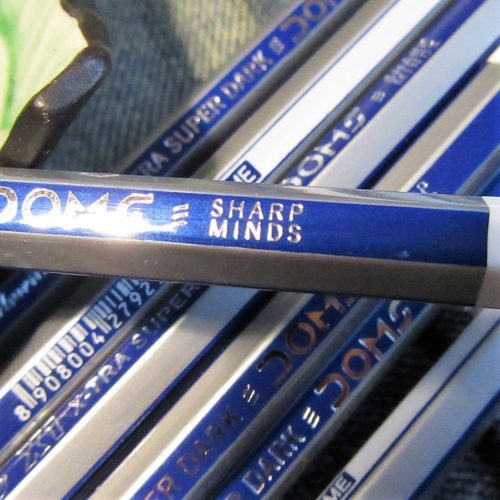
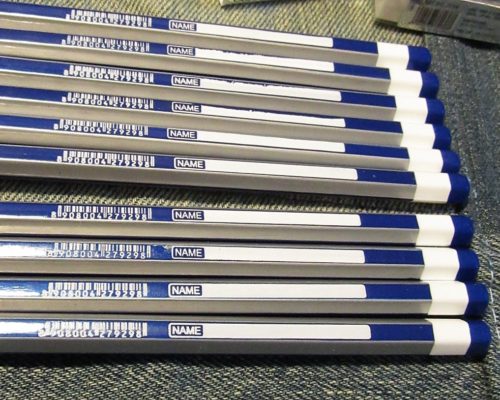
 My package arrived with 10 pencils, a matching translucent blue sharpener, and point protector. The wood appears to be popular or bass. It is definitely not cedar. It’s straight grained and sharpens with ease. Inside the thick lacquer and wood is a thick core. Most of my 10-pack was well centered, though a few were off but not by enough to cause issues with sharpening. The core itself is described as black and it is, it lays down a dark line. It’s smooth and lacks even occasional bits of grit. The core is softer than most HB pencils and I’d describe it as close to a B than HB or 2B. It sits right in a happy spot for point retention and darkness. It is also quite suitable for sketching. The lead is capable of quite a range of tone and value- from a nice light grey to a deep dark. Because it is smooth the graphite lays down effortlessly. I have quite enjoyed it for sketching a few portraits here and there.
My package arrived with 10 pencils, a matching translucent blue sharpener, and point protector. The wood appears to be popular or bass. It is definitely not cedar. It’s straight grained and sharpens with ease. Inside the thick lacquer and wood is a thick core. Most of my 10-pack was well centered, though a few were off but not by enough to cause issues with sharpening. The core itself is described as black and it is, it lays down a dark line. It’s smooth and lacks even occasional bits of grit. The core is softer than most HB pencils and I’d describe it as close to a B than HB or 2B. It sits right in a happy spot for point retention and darkness. It is also quite suitable for sketching. The lead is capable of quite a range of tone and value- from a nice light grey to a deep dark. Because it is smooth the graphite lays down effortlessly. I have quite enjoyed it for sketching a few portraits here and there.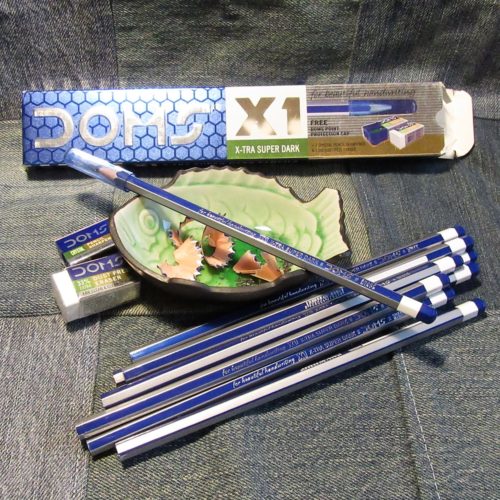
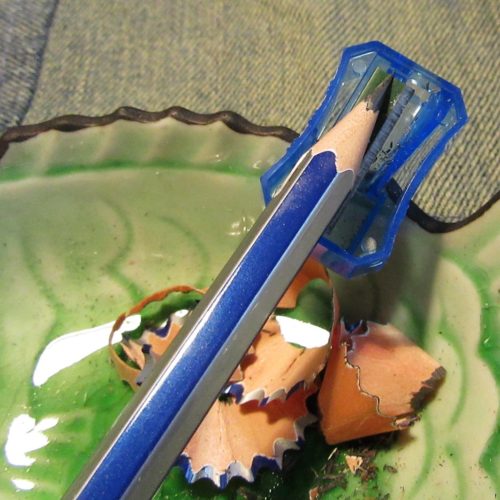 Overall the X1 is a jaunty little pencil that can be used for many uses. Its blue and silver stripes are cheerful. The thickly applied lacquer makes the pencils appear more expensive than they are and the end dip is precisely done. The thick core sharpens well in a Pollux, Masterpiece or Classroom Friendly. You can sketch or write with its smooth dark graphite. These are well worth the wait when you order them from India.
Overall the X1 is a jaunty little pencil that can be used for many uses. Its blue and silver stripes are cheerful. The thickly applied lacquer makes the pencils appear more expensive than they are and the end dip is precisely done. The thick core sharpens well in a Pollux, Masterpiece or Classroom Friendly. You can sketch or write with its smooth dark graphite. These are well worth the wait when you order them from India.
Continue reading
Author Archives: leslie
Review: Dee Charles Designs Pocket Notebook Cover
I have the Rawhide Brown cover but these are also available in Black, Rawhide, and Gold with a variety of colored stitching- black, brown, gold, red and blue. The presentation is in a black box with Dee Charles Designs and logo printed on the top in silver ink. The cover barely fits inside and if I were giving this as a gift I’d probably put a round silver gift elastic around the top or round seals on 2 sides. Perhaps a paper belly band would work well too. Opening the box filled my office with the smell of quality leather. If you like leather, the smell was nice but not overwhelming.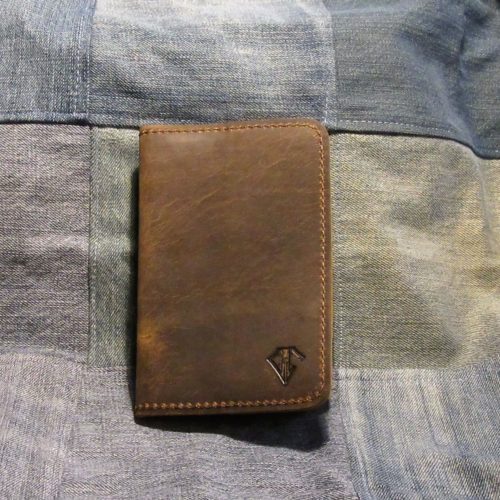 The rawhide color is a distressed brown color that is dark with spots and lighter in others. The front cover sports a small Dee Charles Designs logo in the lower right corner. In use scuffs and scratches make this leather look even better. If you don’t like a scuff or scratch then you can buff them out with a soft cloth. It gets some personality pretty quickly.
The rawhide color is a distressed brown color that is dark with spots and lighter in others. The front cover sports a small Dee Charles Designs logo in the lower right corner. In use scuffs and scratches make this leather look even better. If you don’t like a scuff or scratch then you can buff them out with a soft cloth. It gets some personality pretty quickly.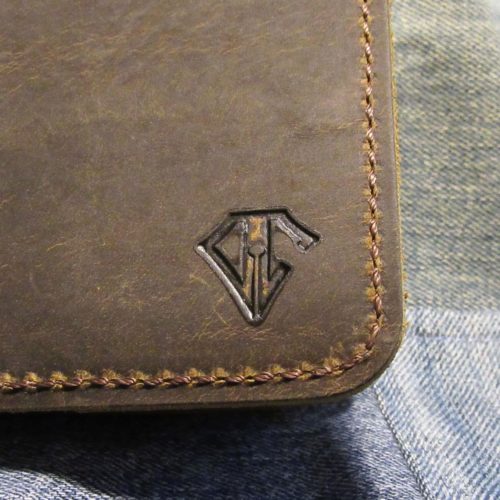
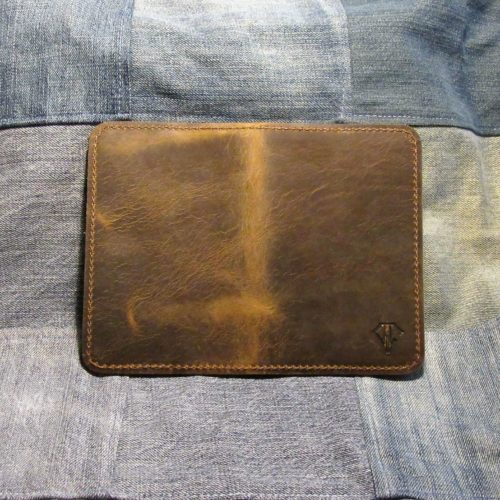 The cover holds 2 notebooks at a time. Sliding a pocket notebook into the pockets was really snug the first few times, and easier over time. Thus far the pockets have only loosened up enough to allow the notebooks to slide in and out more easily. I do not see them getting too loose to hold a notebook snugly. I found that for the first few books notebooks with thinner covers had a tough time being slipped in so I stuck with No Brand Notebooks and Story Supply Co. The rough interior leather burnishes smooth with time and use, but its roughness helps to hold the notebooks inside the cover. The cover is perfectly sized to hold the 2 notebooks there is no excess and no bulge or pressure on the spines.
The cover holds 2 notebooks at a time. Sliding a pocket notebook into the pockets was really snug the first few times, and easier over time. Thus far the pockets have only loosened up enough to allow the notebooks to slide in and out more easily. I do not see them getting too loose to hold a notebook snugly. I found that for the first few books notebooks with thinner covers had a tough time being slipped in so I stuck with No Brand Notebooks and Story Supply Co. The rough interior leather burnishes smooth with time and use, but its roughness helps to hold the notebooks inside the cover. The cover is perfectly sized to hold the 2 notebooks there is no excess and no bulge or pressure on the spines.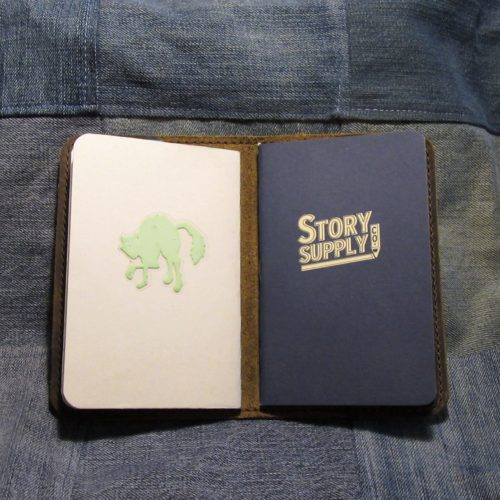 The outer leather is thick and quite stiff, perfect for writing in hand without the need for folding your notebook over onto itself. It took awhile for the leather to break in and be a little more flexible around the spine but it didn’t take too long with constant daily use. One thing that I did find to be a nitpicky thing is that the interior pockets that hold your notebook in place are the same thickness as the exterior leather. A thinner stiff leather would work better. The pockets are also only half the width of the cover so that bulge runs directly down the middle of the page as you write. It is really only a problem when you get to the last few pages of a notebook, but it is a minor nuisance.
The outer leather is thick and quite stiff, perfect for writing in hand without the need for folding your notebook over onto itself. It took awhile for the leather to break in and be a little more flexible around the spine but it didn’t take too long with constant daily use. One thing that I did find to be a nitpicky thing is that the interior pockets that hold your notebook in place are the same thickness as the exterior leather. A thinner stiff leather would work better. The pockets are also only half the width of the cover so that bulge runs directly down the middle of the page as you write. It is really only a problem when you get to the last few pages of a notebook, but it is a minor nuisance.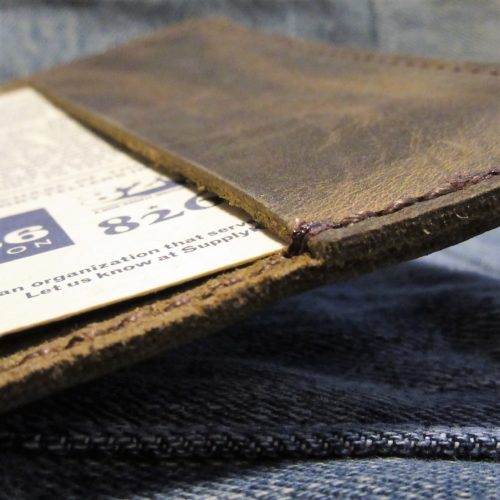
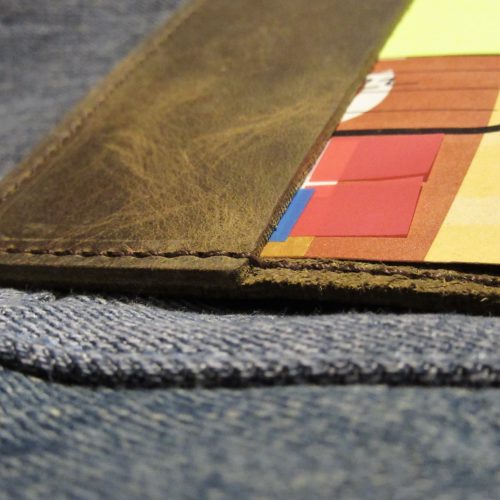

Overall if you are in the market for a really nice leather cover this is a pretty good choice. Thanks to the packaging it also makes a nice gift, for someone else or yourself. It retails for $59 but if you sign up for Pen Chalet’s mailing list you get a coupon you can use on your first order. Continue reading
Review: Baron Fig Stone for Squire Pens
The BF Stone is a small machined cylinder of aluminum with a rounded over top. In the center is a round hole that perfectly fits the Squire pen. It is completely solid. The base is indented and the only place the Baron Fig name is laser etched. Otherwise, the Stone is completely unmarked.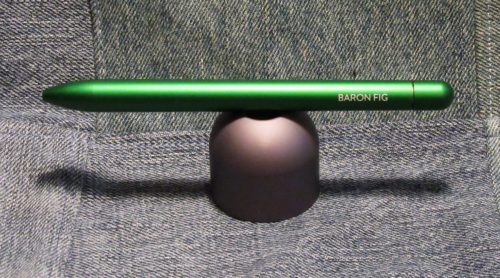 It is available in one color- Baron Fig light gray. This shade matches most of their pens really well. I think it clashes ever so slightly with the bright green of the Experiment. My Spectre looks fabulous in it though.
It is available in one color- Baron Fig light gray. This shade matches most of their pens really well. I think it clashes ever so slightly with the bright green of the Experiment. My Spectre looks fabulous in it though.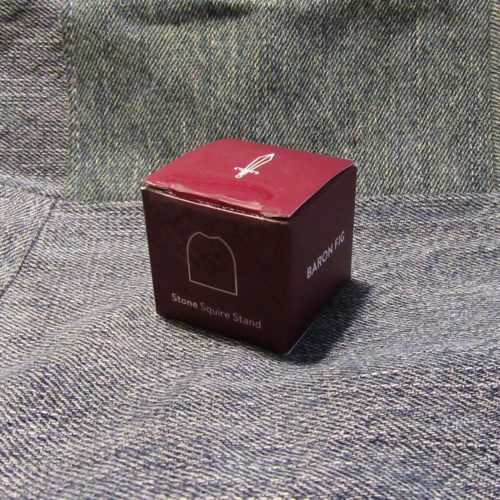

 The Stone is a fabulously minimalistic way to stash your Squire while also keeping it at the ready. It fits into the stone even with the point extended. I’m not sure if that is how you are intended to use it, but I find myself stashing the pen with the point out and only retracting the point at the end of the day. I did test it out to see if I could fit other pens and the only pen that fit was the Paperhate Inkjoy gel. So this is a pen stand for one pen only.
The Stone is a fabulously minimalistic way to stash your Squire while also keeping it at the ready. It fits into the stone even with the point extended. I’m not sure if that is how you are intended to use it, but I find myself stashing the pen with the point out and only retracting the point at the end of the day. I did test it out to see if I could fit other pens and the only pen that fit was the Paperhate Inkjoy gel. So this is a pen stand for one pen only.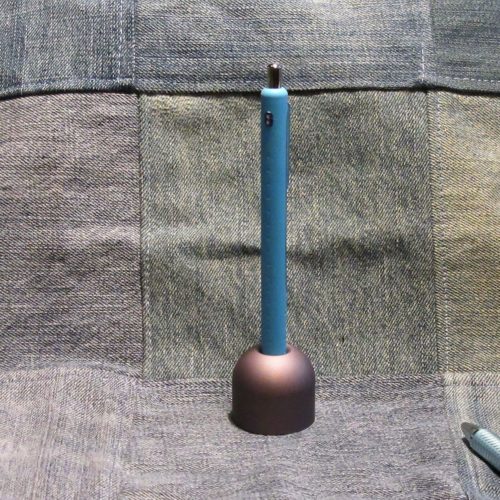
My current writing set up is a little plastic desk that folds up and I find that the Stone slides around on it a bit. I may add a small circle of cork to the base but I also notice it doesn’t do this on my other desk so I might skip the cork. It does look fabulous sitting on my desk with a small cup of pencils nearby.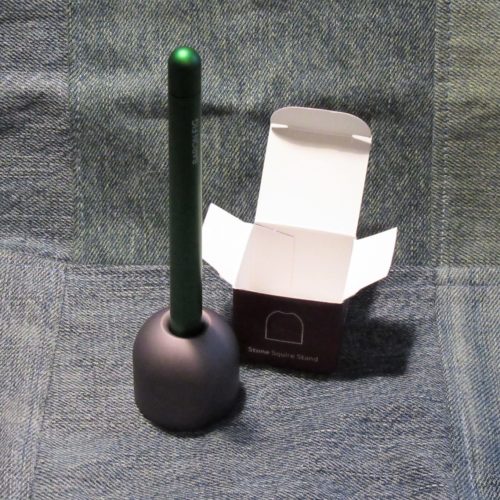
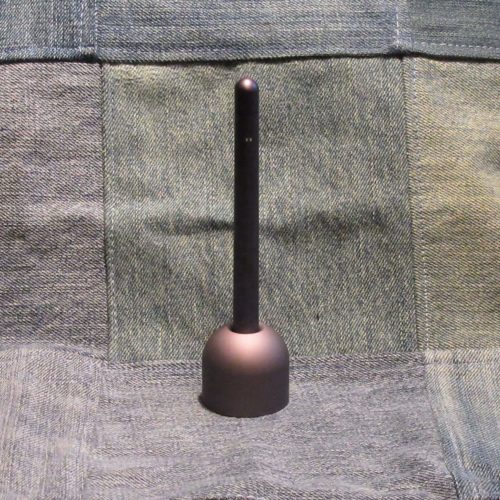
The Stone retails for $24.99 and is a good companion to any Squire. Continue reading
Review: Staples Arc System Notebooks and Refills
My partner was in the market for a planner but needed something that would also work as a notebook. The BF Planner didn’t fit her needs, she really needed more room for notes and the ability to take pages out of the planner as they needed to be discarded or filed. She also needed enough room to plan the day from morning to late afternoon. Bonus points for a planner that didn’t include times, as many of her tasks are fluid. We looked at Target found nothing and then headed to Staples. I’d mentioned the disc binding system to her in passing, this let me show it to her in depth as well as show her how pages could easily be moved around. Even better, Staples had them on sale for 40% off that week. She purchased a full sized calendar model and I picked up a half size notebook.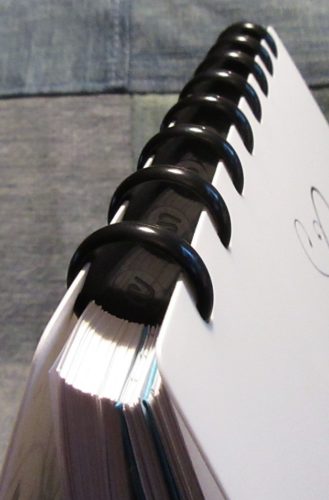 While they had a plethora of fun designs in a variety of color, I went with a relatively plain black and white patterned cover with shiny black disks. I’m likely to cover it with stickers so the pattern mattered less to me than getting something that wasn’t too, bright. It was filled with 60 pages of what seems to be the standard ruled ARC system paper. It should be noted here that after I got my notebook home I noticed that it had a copyright date of 2012, and that the paper has changed since then and is much better for fountain pens. The paper in mine was pretty terrible for any liquid ink, feathering and bleeding. The new paper is great. So check and make sure that your ARC system notebooks and refills have a recent copyright date.
While they had a plethora of fun designs in a variety of color, I went with a relatively plain black and white patterned cover with shiny black disks. I’m likely to cover it with stickers so the pattern mattered less to me than getting something that wasn’t too, bright. It was filled with 60 pages of what seems to be the standard ruled ARC system paper. It should be noted here that after I got my notebook home I noticed that it had a copyright date of 2012, and that the paper has changed since then and is much better for fountain pens. The paper in mine was pretty terrible for any liquid ink, feathering and bleeding. The new paper is great. So check and make sure that your ARC system notebooks and refills have a recent copyright date.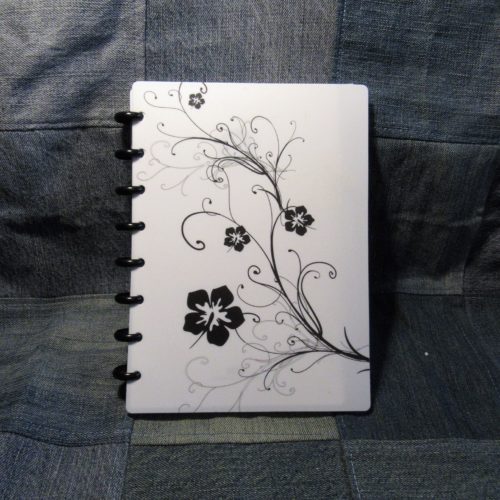
The system itself uses mushroom shaped slots on the binding edge that wrap around a disc with a rounded edge. The slots fit around the disc and the shape keeps the page secure, while allowing you to easily remove the page by pulling up from either the top or bottom edge. The page can be easily reinserted into other parts of your notebook simply by fixing the slots around the discs again. It’s rather ingenious. I found that I could easily insert items of other sizes into my notebook by punching the holes and slotting the item in. I needed to have a fax number handy while I made phone calls the easiest thing was to use the punch and create 2 slots on the edge of the card and slot it into the notebook in the right spot. Eventually I’ll write the numbers into the work bible* but for now, it’s very easy to move the card in an out of the notebook as I’m working.
I found that I could easily insert items of other sizes into my notebook by punching the holes and slotting the item in. I needed to have a fax number handy while I made phone calls the easiest thing was to use the punch and create 2 slots on the edge of the card and slot it into the notebook in the right spot. Eventually I’ll write the numbers into the work bible* but for now, it’s very easy to move the card in an out of the notebook as I’m working.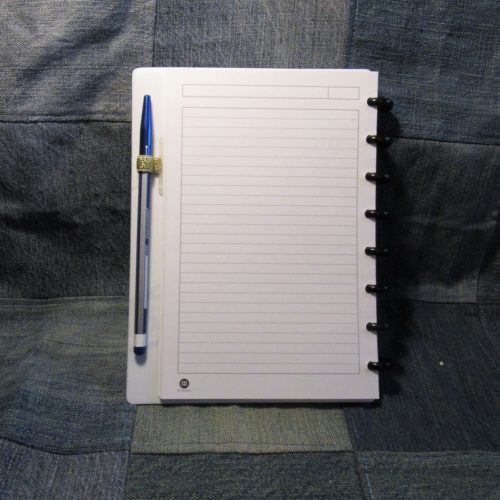 I knew I wanted to have an assortment of lined and dot grid pages. I used gridzzly to print off some of each, which I chopped in half and then punched to fit into the notebook. According to the info insert, my discs can hold 150 pages. I’ve got 100 in there now and it feels decent. I’m not sure I’d want to cart around 150 pages though. The larger discs can hold 200 pages.
I knew I wanted to have an assortment of lined and dot grid pages. I used gridzzly to print off some of each, which I chopped in half and then punched to fit into the notebook. According to the info insert, my discs can hold 150 pages. I’ve got 100 in there now and it feels decent. I’m not sure I’d want to cart around 150 pages though. The larger discs can hold 200 pages. The punch I was able to get at Staples can only do 2 sheets of paper at a time. Which is annoying. I’ve been told that the most of the disc binding punches work for the Staples discs too, but many of those punches will only do 3 sheets at a time, though they are easier to use than the mini punch we bought. I also made some quick dividers to separate my various types of paper from one another.
The punch I was able to get at Staples can only do 2 sheets of paper at a time. Which is annoying. I’ve been told that the most of the disc binding punches work for the Staples discs too, but many of those punches will only do 3 sheets at a time, though they are easier to use than the mini punch we bought. I also made some quick dividers to separate my various types of paper from one another.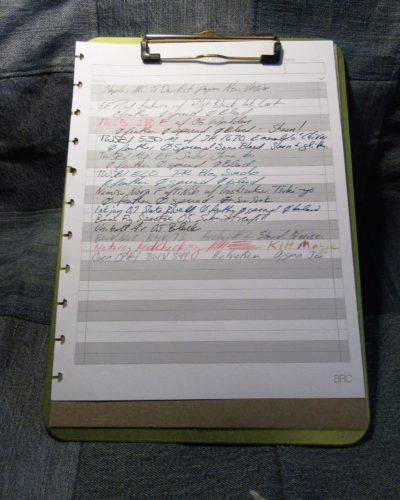
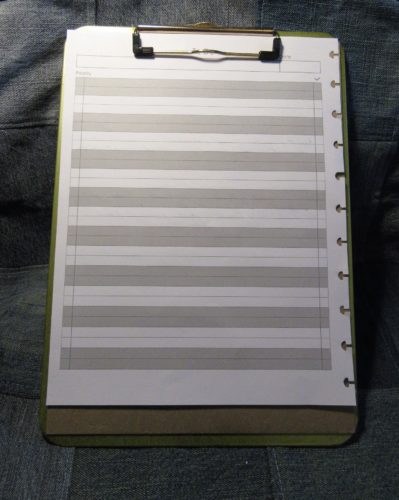
The poly cover I picked up is thick and sturdy. It’s slightly flexible and forms to the things in my backpack. When I have the notebook opened over onto itself I can write in hand, but It is not quite as stiff as I would like. The covers are about an inch wider than the pages, giving plenty of room for tabs and stick on pen and pencil holders.I didn’t buy any pockets or folders to add to my notebook, but I immediately wished I had when I started to use the book at work. I had a few self guided trainings I wanted to take home with me, but didn’t have anywhere to stow them easily. A pocket would have made that job easier.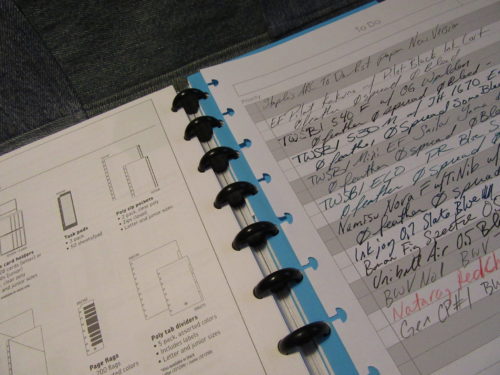 I’ve been carting my ARC around with me for a few weeks at this point and it’s really doing well being pulled in an out of my bag and being tossed onto a desk and leafed through as I make calls to insurance companies. I’ve moved pages from one section to another and around as I group information for insurance company calls. I’ve also been able to tear out individual pages and toss them without mess.
I’ve been carting my ARC around with me for a few weeks at this point and it’s really doing well being pulled in an out of my bag and being tossed onto a desk and leafed through as I make calls to insurance companies. I’ve moved pages from one section to another and around as I group information for insurance company calls. I’ve also been able to tear out individual pages and toss them without mess.
There are many advantages with the disc bindings over standard 3 ring binders- the mushroom shaped slots are less likely to tear, the pages don’t shift as much so if you use pencil your writing is less likely to blur. A decided down side of the system is that the punches are ridiculously expensive and the cheaper versions are still much more expensive than even a decent 3-hole punch. If you plan on using this system at all you NEED a punch. It is the only way this system makes sense. You could go all in and buy all the various parts and pieces at Staples/Office Depot/Levenger/ online and never print your own paper or inserts but at some point you may want to corral work info or a print out into your system and you’ll need a punch. The punch we purchased, the only one available at our local Staples is only capable of punching through 2 sheets of 20lb paper or 1 sheet of cardstock at a time. Let me tell you, the 40 pages of paper I printed? That went really slow at 2 sheets at a time. Very annoying. In sharp contrast the $20 3-hole punch I own can punch 20, 20lb sheets at time. It’s a beast.
In short the disc bound system is awesome. It works great. The pages don’t shift or rub against one another. It was cheap at 40% off to get into, but if I were looking to start out at full price the entrance fee can be VERY intimidating, especially if you are looking at using the leather or fancier covers. The purchase of a punch is also a big investment and like I detailed above, completely necessary if you plan on going all in on the system. Frankly I like the system, but I have been a huge fan of 3-ring binders for years. If you are someone who likes to move info around or need to the disc systems will appeal to you. If you can find a coupon you can get a setup of the Happy Planner at Michael’s for 40 to 50% off. I like the system a lot and it is very functional and useful for planning out projects and gathering research. So worth it but pricey. Continue reading
Review: Baron Fig Strategist aka 3×5 Notecard
The Strategist is a heavyweight white colored 3×5 card with pale gray dot grid ruling on one side with a blank reverse side. Each $9 package has 100 cards with rounded corners.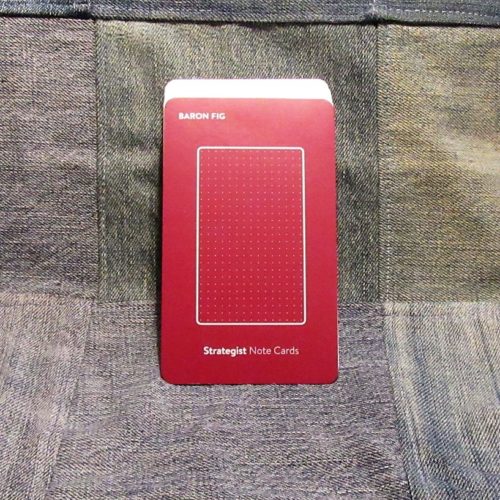

My package arrived at the right moment for me to write down the beats of my Nano novel in preparation for the second round of edits. In this I wrote with a variety of materials from my BWV No1 to the Mitsuboshi Uni*Star 2B to my Namisu Nova inked with Robert Oster FIre and Ice and my TWSBI 540 inked with RO Walden. The cards handled each ink and graphite with ease. I noted that the card is smoother and less toothy than the paper in the Confidant and Vanguards. Despite lacking the tooth of BF’s other paper it handled the pencils with ease and graphite erased easily. Even better, the cards accepted fountain pens with ease. I noted no feathering or bleeding. My pens stayed true to their nib size. The blank backside of each card was usable too. There wasn’t any show through. 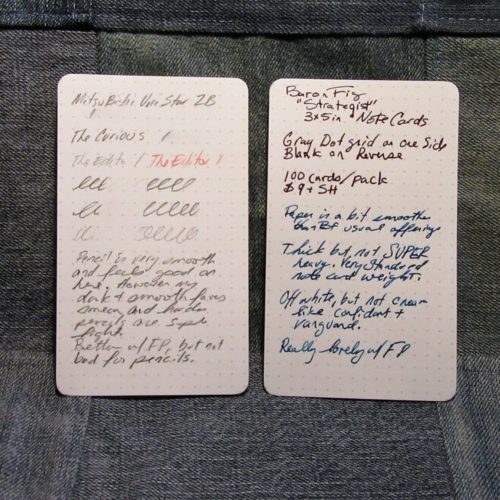
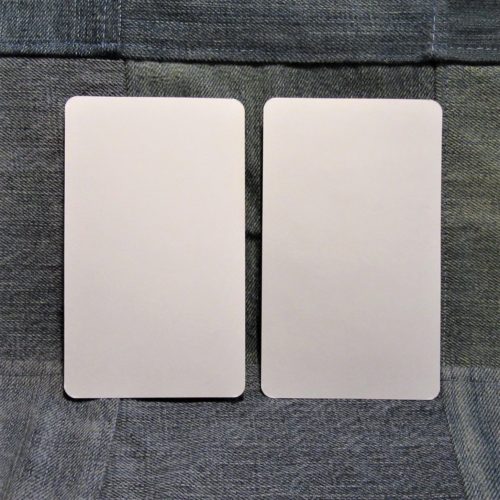

I love dot grid and I like notecards. These notecards perform as well as any other premium card out there and are priced in the premium tier. At $9 a pack they are 9 cents per card. You can get other brands for less but they won’t work well with a fountain pen or liquid ink. I’ve found that many brands now use thinner cardstock, so even brands that worked well enough in the past are less useful now because the thin cardstock allows for bleed and show through. For $9 you get cards that will work with anything you use to write. Continue reading
Continue reading
Review : Pilot Kakuno Fountain Pen
The Pilot Kakuno is a student’s or beginner’s fountain pen, with a focus on children. As such it is available in a wide variety of colors with standard fine and medium nibs generally available here in the US. Along with that, Pilot has chosen to only import some of the colors available to the US market. My Kakuno is an import clear version and has an extra fine nib. The shiny steel nib has a cute smiley face with tongue out on the top.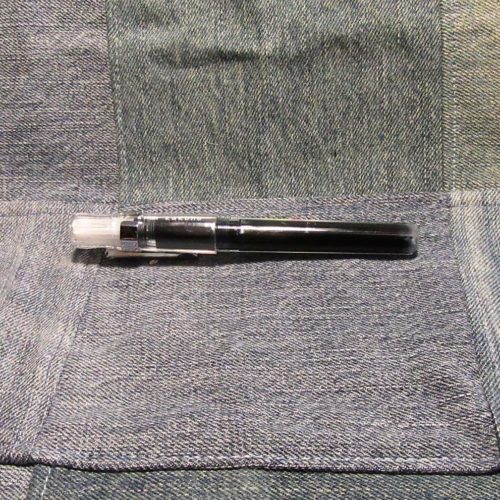
The EF nib is made of steel and with a small amount of smoothing is silky smooth on good paper. It skates across my Baron Fig Confidant as I create my Work Bible* I also find it quite nice in my pocket notebooks from Field Notes to Write to Lodestone. It also feels pretty decent on the crappy paper at work. Despite the nice feeling of the nib on the various paper, the papers all respond to the ink as one would expect for that brand. The EF nib is needle thin with a hint of bounce which is nice. It doesn’t create much variation in the line but it feels good as I’m writing.
The grip section is subtly triangular shaped while the rest of the pen is hex shaped. The clear plastic is extremely light weight. Empty it comes in at 11.3g. With a cart it comes in at 12.5g. It’s not a big pen but it isn’t tiny either. The body of the pen is roughly the same size as a Lamy Safari but the cap is slightly smaller. It can be used unposted comfortably or posted without the weight being thrown off. I really like the weight and size of the pen- I can write for long periods without hand fatigue that I get from heavier pens. The Kakuno is great for long writing periods.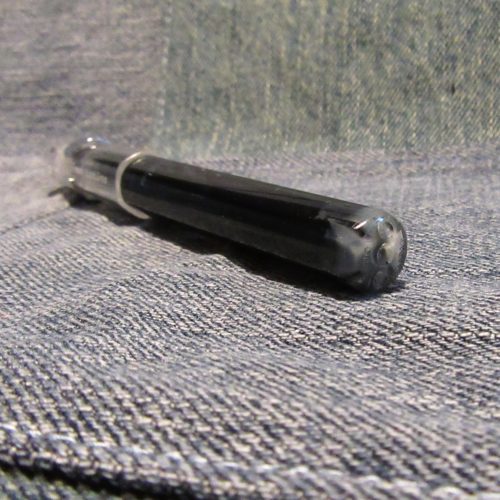
Because the pen is hexagonal and roughly the same diameter as a Kaweco Sport I wondered if the Kaweco clip would fit. I ordered one of the older style, plain clips rather than one that has the Kaweco logo emblazoned on the clip. I chose silver so it would match the steel nib. The facets don’t match perfectly but it is snug on the cap. It is a functional addition to the pen, as I need a clip for my DayJob.
IN the several week’s I’ve been using this pen it has survived being clipped to the plackets of my work shirts and being tossed into the pockets of my work pants. The snap on cap stays put and has yet to fall off. The plastic of the pen body has not yet cracks or shown any wear. Despite banging around in my pocket with my wallet, pencil sharpeners and can tabs (don’t ask) the pen hasn’t developed any scratches as of yet.
Despite it being an EF pen the ink flow is good and you get a decent amount of ink on the page. This is both good and bad. Like with the gel pens I’ve written about this means I’m blowing through ink carts very quickly. I’ve been using at least one a week, more often nearly 2. Certainly this can add up in cost it accumulates more frustration for me in terms of plastic waste. I prefer to use a converter but it is not realistic that I refill from a bottle at work. A cartridge I can swap on the fly as I work. I’ve taken to refilling my carts. I’m also looking at filling the holes on the back of the pen body so I can convert to eyedropper.**
Anyway, the Kakuno with an EF nib is great for crappy paper and even better on nice paper. The price for the opaque colors is about $11.75 while the clear is around $12.50 on JetPen. I really like it for my workplace The smiley face puts a smile on some of my client’s faces and can insert some levity into an otherwise difficult situation. It works great on crappy paper and feels good in hand. For the $12.50, the Kakuno is a great little pen.
Pens for Crappy Paper
I’ve discussed in previous posts how my workplace offers the finest of the cheapest papers that Staples sells. Every quarter they buy 10 to 12 cases of whatever is the cheapest at that moment. This means the paper is never the same, though it is always one of Staples finest cheapest offerings. Sometimes we get 30% recycled, sometimes it’s not recycled but bright white whatever. You get my drift. The paper varies and it’s always rough and absorbent. As much as I’d prefer to fill out my paperwork with my Namisu Nove F with a Ti nib loaded up with Iroshizuku Tsuki-Yo, it’d feather and bleed through any of the papers. For awhile I was was using an EF or F Platinum Preppy loaded up with Diatrementis Deepwater black. The combination does okay on some of the cheap crappy paper, but not the most recent batch. This has led me on a quest to find the best gel and rollerball pens for crappy paper.
Simply because I’m on a quest for the best pen for the crappiest of terrible paper doesn’t mean that I want to sacrifice my writing experience. I want to keep a smooth enjoyable experience despite the hardship of writing on terrible paper. There are many ballpoints that do well on the crappiest of crappy paper, but I’m not including these in this discussion for the simple fact that I already know they work on crappy paper. You want a solid ballpoint for crappy paper- get a Bic Cristal or Parker Jotter. You want gel? There is much more to discuss.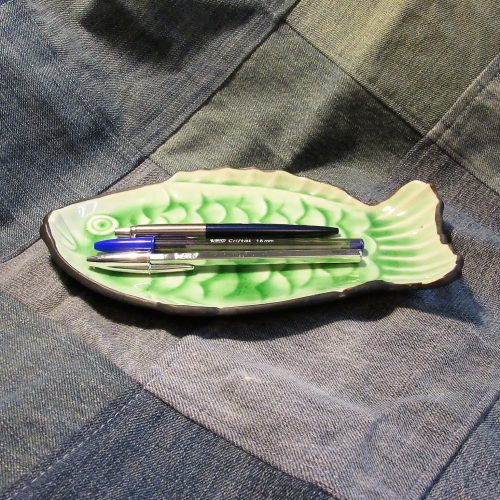
I’ve already written about how a Pilot G2 is always a solid choice– in both black and blue ink for crappy paper. It has become a go to for my work place. Any point size seems to work well. I stick with the standard offering of the 0.5. I did pick up the Pilot B2P, which is loaded with a G2 0.7 refill and it works quite well. So add the Pilot B2P gel to your G2 choices.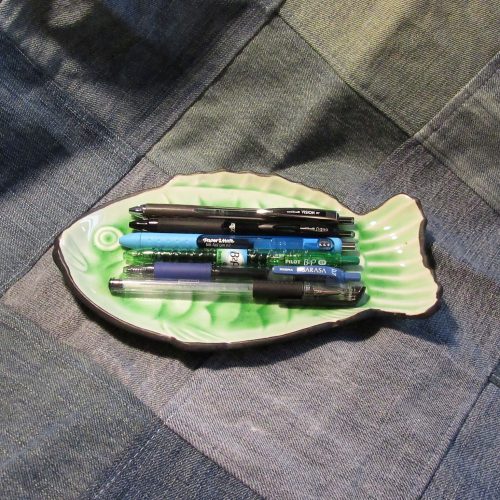
While I quite enjoy the Paperhate InkJoy gel pen in my pocket notebooks and journals when I use it on crappy absorbent paper I blow through the refills incredibly fast. The InkJoy gel seems to flow faster on crappy paper. It is already a firehose of a pen, but cheap paper makes it write wetter and drain faster. Also I’ve noticed that it has a tendency to bleed through on the paper. These faster flow and bleed through makes the Inkjoy a poor choice for crappy paper.
The Uniball Signo series in all colors does well on the crappy paper. It performs as well as the G2. In my mind I like the Signo over the G2 because I’ve never had one dry or skip as I have with the G2. The Signo writes and writes. Plus the BLX colors are just great.
Another Uniball, the Vision, is a rollerball rather than gel ink like the Signo, works very well on most of the paper at work. It writes and writes with good ink flow. Occasionally I’ll notice a few spots of bleed through, but that seems to be a rare occurrence. I use these in the standard black only.
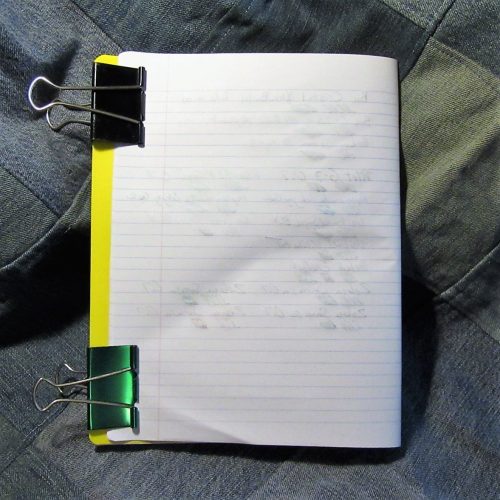
I’ve used a few Pentel EnerGel pens, and while I like the blue on the crappy paper at work, the black isn’t as good. I noticed that the edges of the line are darker than the center. My lines are less dark because of this. The ink flow is good and it doesn’t skip, nor does it bleed. I simply do not like the darker line edges the black produces. The blue does not seem to exhibit this characteristic. I prefer to buy these in refills and fill my Pentel Alloy body- as I always seem to snap the Energel plastic bodies in half before the pen is finished.
The unsung hero of crappy paper is the Zebra Sarasa. Not the Sarasa Clip, just the regular old Sarasa you can find in multipacks in any Staples, and oddly as Singles in many Walgreen’s locations in the US. The 0.7 retractable Sarasa is a decent and solid pen on crappy paper. On better paper it tends to skip and show that weird lighter in the middle line variation I saw with the EnerGel. The Sarasa doesn’t skip, bleed, or anything but write on crappy paper. From the moment I remove the waxy blob on the tip to the moment the refill is drained, it writes and writes.* Combine the Sarasa’s writing with it’s low price and availability it has become a staple in my cheap paper arsenal.
Many of my workplaces have offered Staples brand capped black gel ink pens in 0.7mm tips. While I prefer a click pen at my DayJob, I grab these when they are offered. These seem to be modeled after a Uniball Signo UM-151. They may even be made for Staples by Uniball. (The ink isn’t waterproof or lightfast.) That said, they perform as well as the Signo 207 series of pens on crappy paper- really well. They write and write without skipping or bleeding. That said, the refills are smaller than in the Uniball or Sarasa, so I tend to drain these pens faster than others.
In terms of affordability, the Staples is the most affordable. Because so many workplaces have accounts with Staples you can often get the person who orders to order you a box of 12 of the Staples pens at least once. If you cannot get the Staples pens ordered for you, the Sarasa is probably the most affordable next option. The Sarasa can often be found for less than the G2 or the Signo. If you look for sales, other pens are an option. I’ve been trying to keep my options to be $1 or less per pen. I’ve managed to score some serious deals in the post Back-to-School Sale season- I snagged 5 Indigo Sarasa for 10 cents each. Keeping a close eye on sales and clearance racks has helped me to find enough pens to last at least the next year at my DayJob.**
Reflection: The Thrill of the Hunt
This post was written by Deirdre Scolardi, 1/3rd of RSVP and the person behind The Weekly Pencil.
I think for me, besides the excitement that comes with using my stationery goods, is the process I sometimes go through to get there. I am a very organized person and with that organization comes meticulous list-making. Whenever I dive deep into a hobby, I make lists. Lists of things I already have followed by things I want followed by the categorization of those lists into subcategories when necessary. Oftentimes I find myself spending hours compiling these lists and in the end wind up never acquiring half of what is on them.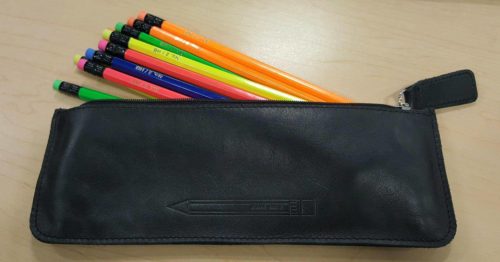 I delve deep when I discover something new. Not only do I need the “starter” stuff, but I need the best stuff. I need to catch up and keep up with the Joneses that have been collecting special edition pencils since they started making special edition pencils. But wait. What about all those Field Notes editions I missed out on? Or how about the Write Notepads subscriptions? Baron Fig’s latest Squire? You see my dilemma here. Yes. I want all of those things, but for what? The ability to say that I have those things? God knows I would NEVER use my last 211 (I have more than one so don’t fret).
I delve deep when I discover something new. Not only do I need the “starter” stuff, but I need the best stuff. I need to catch up and keep up with the Joneses that have been collecting special edition pencils since they started making special edition pencils. But wait. What about all those Field Notes editions I missed out on? Or how about the Write Notepads subscriptions? Baron Fig’s latest Squire? You see my dilemma here. Yes. I want all of those things, but for what? The ability to say that I have those things? God knows I would NEVER use my last 211 (I have more than one so don’t fret).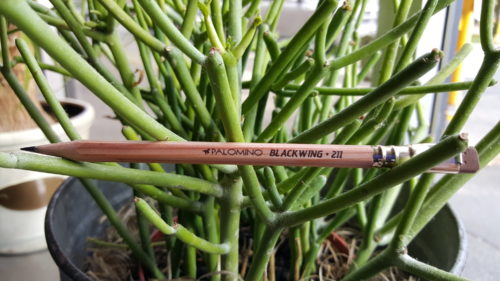 I often wonder what motivates people in their own hobby that they like. It is the time spent engaging in the hobby itself or establishing one’s self in that hobby’s community? Take the stationery world. Pencils to be more exact. What if, upon joining the Erasable community, you are given a Starter Pack and in that Starter Pack is a bunch of pencils, erasers, sharpeners, notebooks, etc.? Sure, you would enjoy using all of that free stuff, but would you enjoy it for hours, days, weeks, months, YEARS? Probably not. But if you were instead given a list of things that you should check out, perhaps that joy would be continuous because it would require you to acquire those things yourself. Acquisition is the key here.
I often wonder what motivates people in their own hobby that they like. It is the time spent engaging in the hobby itself or establishing one’s self in that hobby’s community? Take the stationery world. Pencils to be more exact. What if, upon joining the Erasable community, you are given a Starter Pack and in that Starter Pack is a bunch of pencils, erasers, sharpeners, notebooks, etc.? Sure, you would enjoy using all of that free stuff, but would you enjoy it for hours, days, weeks, months, YEARS? Probably not. But if you were instead given a list of things that you should check out, perhaps that joy would be continuous because it would require you to acquire those things yourself. Acquisition is the key here.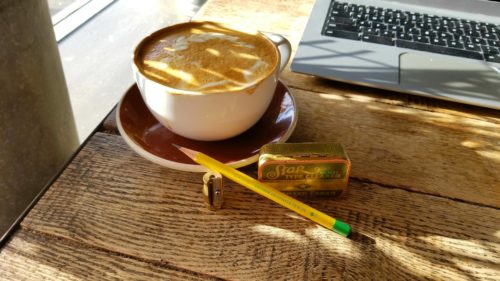 Sure, I’d love for someone to hand me a Blaisdell Calculator 600 (hint!! [I kid]), but it would be a hell of a lot more fun to search for one and find that holy grail on my own. If I did acquire a Calculator 600 I wouldn’t use it, but then how would I enjoy it? I couldn’t. It reminds me of the time I acquired an original Blackwing 602. It did not live up to the hype and I much rather use a modern day 602. It made me ask myself: “Do I want these pencils to collect them or to use them?” Stationery items are meant to be used– they are tools after all. It was at that point, at least for me, that I realized while I enjoy using pencils and stationery items, I enjoy the stories that come along with finding those rare items so much more.
Sure, I’d love for someone to hand me a Blaisdell Calculator 600 (hint!! [I kid]), but it would be a hell of a lot more fun to search for one and find that holy grail on my own. If I did acquire a Calculator 600 I wouldn’t use it, but then how would I enjoy it? I couldn’t. It reminds me of the time I acquired an original Blackwing 602. It did not live up to the hype and I much rather use a modern day 602. It made me ask myself: “Do I want these pencils to collect them or to use them?” Stationery items are meant to be used– they are tools after all. It was at that point, at least for me, that I realized while I enjoy using pencils and stationery items, I enjoy the stories that come along with finding those rare items so much more.
Review: KUM Masterpiece
I mention the KUM Masterpiece pretty often in my pencil reviews. With good reason too, it’s a fantastic sharpener. Compared to the dramatic teasing of the Pollux from M+R, KUM did the roll out for the Masterpiece juuuust right. Initially it was only available in Germany then someone was able to do a group buy for a decent price. Finally, CWPE was able to get them in stock. The Masterpiece is machined from a solid block of aluminum, possibly an alloy. With a sliding blue plastic stop for your lead. The stop also has a slot on the underside to hold 2 replacement blade, and arrives with 2 in the slot. The blades are standard sharpener blades. I use M+R blades that are available in 10-packs all over the place. The Masterpiece arrives swaddled in neoprene and in a hard plastic case. I’ve ditched my plastic and neoprene for a mini mint tin, but that matters not. It comes with a neat neoprene case for carting around in your bag in cushioned safety.
The Masterpiece is machined from a solid block of aluminum, possibly an alloy. With a sliding blue plastic stop for your lead. The stop also has a slot on the underside to hold 2 replacement blade, and arrives with 2 in the slot. The blades are standard sharpener blades. I use M+R blades that are available in 10-packs all over the place. The Masterpiece arrives swaddled in neoprene and in a hard plastic case. I’ve ditched my plastic and neoprene for a mini mint tin, but that matters not. It comes with a neat neoprene case for carting around in your bag in cushioned safety.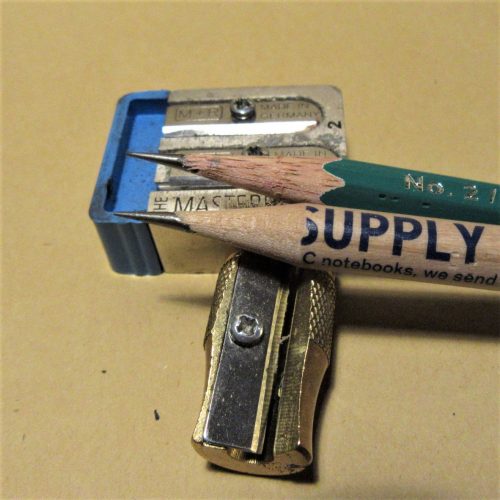 To use the Masterpiece you first sharpen the wood away in hole 1, which is on the left side of the sharpener. On a pencil with a well centered core it sharpens only the wood away. After you’ve shaved off the wood you slide the exposed lead into hole number 2 to the right, using a light touch it shaves off the graphite to a perfectly pointy long point. With practice you can learn to stop before you get a needlepoint hat snaps when you touch it to paper. I’ve found that I can usually touch up my point 2 or 3 times without sharpening the wood again.
To use the Masterpiece you first sharpen the wood away in hole 1, which is on the left side of the sharpener. On a pencil with a well centered core it sharpens only the wood away. After you’ve shaved off the wood you slide the exposed lead into hole number 2 to the right, using a light touch it shaves off the graphite to a perfectly pointy long point. With practice you can learn to stop before you get a needlepoint hat snaps when you touch it to paper. I’ve found that I can usually touch up my point 2 or 3 times without sharpening the wood again.
If the blade in hole 2 is dull it will take forever to get a point and occasionally the lead will snap off. I rotate my blades. So I’ll recycled blade 1, moving the dull blade 2 to hole 1 and putting a fresh blade onto hole2. Generally the Masterpiece will sharpen any pencil any time without issue. It just works 99% of the time, unlike the Pollux. Replacement blades are cheap.
The Masterpiece is available for $18 plus shipping at CWPE and $15 at Pencil(dot)com plus rather high shipping. You can also get it at JetPens for $22, and free shipping at $25.
Pricing aside, the Masterpiece is ready to go the moment you get it and it just works and works. This thing is a workhorse of a sharpener. Sharpening everything from the cheapest Dixon no name to the priciest Blackwing volumes. I love it. Continue reading
Review: California Typewriter
This post is written by Harry Marks, the mind behind one of my favorite podcasts, Covered. you should check it out Harry’s interview style is excellent.
I was unable to catch California Typewriter, a documentary from Doug Nichol, in theaters during its limited run, so instead I purchased it from iTunes a few days before Thanksgiving. I’m not sure what I expected. Certainly a heavy dose of hipsters nostalgic for an era they never lived so as to set themselves apart from the iPad crowd. However, this movie, unlike others centered around the tools of creators, didn’t give me what I expected and in fact, delivered something more.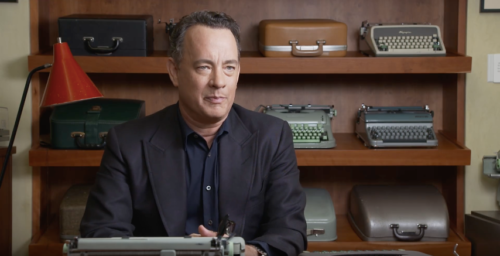
 Looking at the poster, with its flaming sheet of paper sticking out the top of a vague, blue 1970s machine, one might think the movie was about the men in the four boxes at the top. Tom Hanks is arguably the most famous typewriter collector in the world, but he doesn’t feature that heavily in the film; John Mayer, David McCullough, and Sam Shepard are far more prominent, perhaps because the typewriter plays a bigger role in their creative endeavors. But these celebrities are not the focus of the film. They are more akin to hype men, expounding on the typewriter’s beauty and longevity while the rest of the movie focuses on its namesake: a tiny shop in Berkley, California that repairs, restores, and resells vintage typewriters.
Looking at the poster, with its flaming sheet of paper sticking out the top of a vague, blue 1970s machine, one might think the movie was about the men in the four boxes at the top. Tom Hanks is arguably the most famous typewriter collector in the world, but he doesn’t feature that heavily in the film; John Mayer, David McCullough, and Sam Shepard are far more prominent, perhaps because the typewriter plays a bigger role in their creative endeavors. But these celebrities are not the focus of the film. They are more akin to hype men, expounding on the typewriter’s beauty and longevity while the rest of the movie focuses on its namesake: a tiny shop in Berkley, California that repairs, restores, and resells vintage typewriters.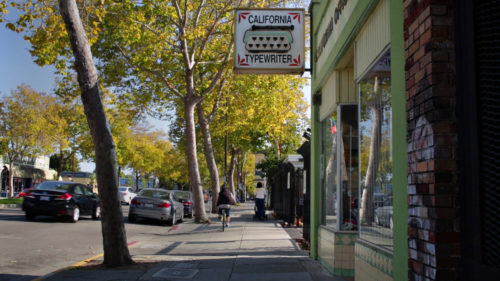
 Herb Permillion, the store’s owner, his daughters, and repairman Kenneth Alexander keep things running four days a week. It’s almost enough to validate the “small businesses are the backbone of the American economy” platitude politicians spout right before they vote to tax the hell out of them. I found myself pausing and searching eBay throughout the film because of the way Ken talked about a particular bell sound or how his fingers danced over a machine as though he’d built it himself. This family of do-or-die typewriter aficionados lives and breathes the clicks and clacks of yesteryear and it is impossible to not get swept up in their genuine love for these objects.
Herb Permillion, the store’s owner, his daughters, and repairman Kenneth Alexander keep things running four days a week. It’s almost enough to validate the “small businesses are the backbone of the American economy” platitude politicians spout right before they vote to tax the hell out of them. I found myself pausing and searching eBay throughout the film because of the way Ken talked about a particular bell sound or how his fingers danced over a machine as though he’d built it himself. This family of do-or-die typewriter aficionados lives and breathes the clicks and clacks of yesteryear and it is impossible to not get swept up in their genuine love for these objects.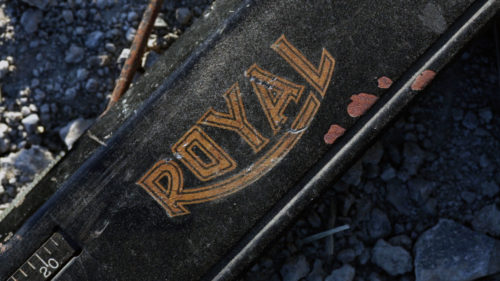 Some might say a documentary about people repairing typewriters wouldn’t be very entertaining (I beg to differ), so when the cameras aren’t inside the shop, they’re pointed at the men and women who collect or make their living from typewriters. When Tom Hanks talks about one of the over 200 typewriters in his collection, it’s like watching Jay Leno discuss a rare car in his garage. You can’t help but smile and feel the warmth of his admiration for them. 1776 author David McCullough writes all his books on an old Royal in his backyard writing shed. Silvi Alcivar is a “poet on demand” who composes short verse on her red Royal Custom III in subway stations and at street fairs.
Some might say a documentary about people repairing typewriters wouldn’t be very entertaining (I beg to differ), so when the cameras aren’t inside the shop, they’re pointed at the men and women who collect or make their living from typewriters. When Tom Hanks talks about one of the over 200 typewriters in his collection, it’s like watching Jay Leno discuss a rare car in his garage. You can’t help but smile and feel the warmth of his admiration for them. 1776 author David McCullough writes all his books on an old Royal in his backyard writing shed. Silvi Alcivar is a “poet on demand” who composes short verse on her red Royal Custom III in subway stations and at street fairs.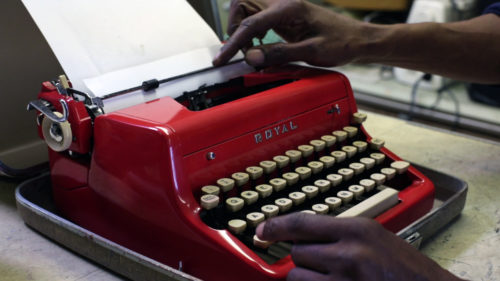 Not all featured are writers and poets, though. Jeremy Mayer creates amazing sculptures of animals and humans out of old typewriter parts. I couldn’t help but cringe at his prying apart old Selectrics and Coronas to construct fingers and cheek bones for his skeletal people. When a film is dedicated to the preservation of such beautiful machines, seeing someone mangle them to feed their Frankenstein-like need to create feels like watching a person make wallpaper from torn-out Bible pages. Mayer’s work is fascinating in a macabre kind of way.
Not all featured are writers and poets, though. Jeremy Mayer creates amazing sculptures of animals and humans out of old typewriter parts. I couldn’t help but cringe at his prying apart old Selectrics and Coronas to construct fingers and cheek bones for his skeletal people. When a film is dedicated to the preservation of such beautiful machines, seeing someone mangle them to feed their Frankenstein-like need to create feels like watching a person make wallpaper from torn-out Bible pages. Mayer’s work is fascinating in a macabre kind of way.
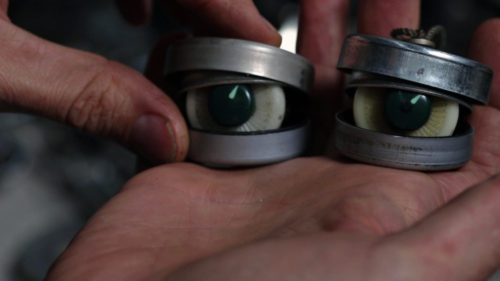 Regardless of how each individual uses (or abuses) typewriters, every single person in California Typewriter has a different and unique reason for why he or she enjoys them, be it the sound, or the joy of an analog lifestyle, or the satisfaction of putting actual words on an actual page. This is what’s most inspiring about the documentary: everyone in it is different, just like every typewriter is different. The bells chime in different tones. An Olympia has a crispier “chunk” than a Smith-Corona. Keys are spaced and shaped differently, and each of those characteristics is something to either entice or repel a potential owner. One person makes sculptures with parts while another makes music. One types non-fiction in a shed while another types poetry in public. The typewriter can be a symphony and a work of art, and while different people may use it in different ways, its purpose is clear: to create.
Regardless of how each individual uses (or abuses) typewriters, every single person in California Typewriter has a different and unique reason for why he or she enjoys them, be it the sound, or the joy of an analog lifestyle, or the satisfaction of putting actual words on an actual page. This is what’s most inspiring about the documentary: everyone in it is different, just like every typewriter is different. The bells chime in different tones. An Olympia has a crispier “chunk” than a Smith-Corona. Keys are spaced and shaped differently, and each of those characteristics is something to either entice or repel a potential owner. One person makes sculptures with parts while another makes music. One types non-fiction in a shed while another types poetry in public. The typewriter can be a symphony and a work of art, and while different people may use it in different ways, its purpose is clear: to create. After watching the film, I felt compelled to drop a fresh sheet of paper into my own Smith-Corona and start a new short story. My words hit the page like gunfire. Sure, it was nice to slow down and get away from the notifications and dings of new email, but more than that it was fun. Typewriters are fun. Typing on a typewriter is fun. Fun is something not talked about when writing on a computer or even by hand. One is mundane, the other a chore (I’m failing NaNoWriMo by hand and it is less than amusing). The people of California Typewriter, both the shop and the film, embrace the fun side of the tools we take for granted. Their enjoyment is almost better than the footage of all the beautiful typewriters they surround themselves with. Almost.
After watching the film, I felt compelled to drop a fresh sheet of paper into my own Smith-Corona and start a new short story. My words hit the page like gunfire. Sure, it was nice to slow down and get away from the notifications and dings of new email, but more than that it was fun. Typewriters are fun. Typing on a typewriter is fun. Fun is something not talked about when writing on a computer or even by hand. One is mundane, the other a chore (I’m failing NaNoWriMo by hand and it is less than amusing). The people of California Typewriter, both the shop and the film, embrace the fun side of the tools we take for granted. Their enjoyment is almost better than the footage of all the beautiful typewriters they surround themselves with. Almost.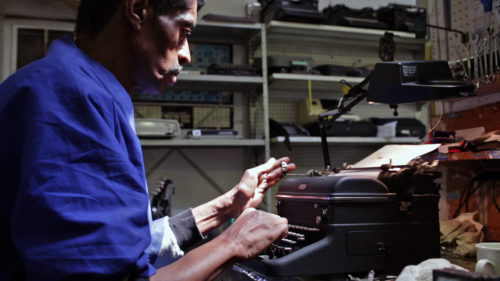 For me, California Typewriter has the potential to be the On Writing of movies, a well to revisit and quench one’s thirst when the words run dry. One viewing and I had already slipped a sheet of paper through the platen. No operating systems to update, no Internet required, no interruptions, just me and the words. You may call us hipsters or contrarians. You may look down on our love of the old ways, but our machines are 60, 70, 80 years old or more. They have lasted through numerous presidents, World Wars, the dot com bubble, and they may even outlast us.
For me, California Typewriter has the potential to be the On Writing of movies, a well to revisit and quench one’s thirst when the words run dry. One viewing and I had already slipped a sheet of paper through the platen. No operating systems to update, no Internet required, no interruptions, just me and the words. You may call us hipsters or contrarians. You may look down on our love of the old ways, but our machines are 60, 70, 80 years old or more. They have lasted through numerous presidents, World Wars, the dot com bubble, and they may even outlast us.
California Typewriter avoids the common traps found in similar documentaries. It is more than a celebration of an enduring creative tool. It is proof that obsolescence is not inevitable, but a suggestion as long as these machines can enchant new audiences and skillful hands continue to keep them running. We’ve embraced analog because despite the time it takes to complete a task, it is more satisfying. Tactile. Personal. I cannot think of a better representation of these principles than California Typewriter.
California Typewriter is available now for rent or purchase on iTunes.
Harry Marks is the host of the literary podcast COVERED where he interviews authors about their books and the writing process. His fiction can be read at HelloHorror and in Plumbago Magazine.